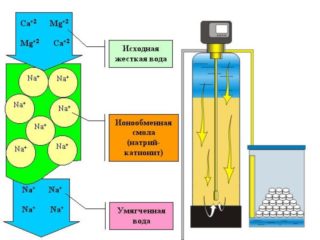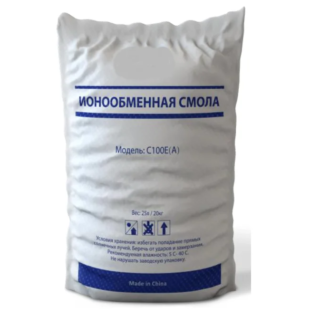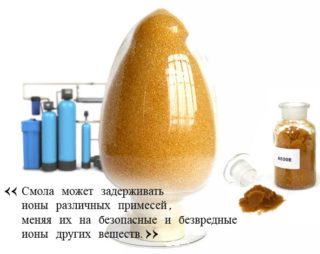Ion exchange resins are compounds that do not dissolve at a high molecular weight level and are capable of producing a reaction when interacting with the ionic elements of a solution. Ion exchangers have a three-dimensional gel or macroporous structure. Resins are used for water purification, softening and demineralization.
Classification of resins
Such compositions are subdivided into cation-exchange, anion-exchange, bipolar.
Cation-exchange compounds can be weakly acidic and strongly acidic. The latter are able to exchange cations regardless of the pH level. The first ones work only with an indicator of at least 7.
Anion exchange compositions are strongly basic and weakly basic. The first anionites have the property of anion exchange in solutions at any pH values, which weakly basic anionites cannot. For them, the indicator should be between one and six. Anionites of intermediate and mixed activity are also found.
Properties and principle of operation
When a liquid is filtered through a resin filter, it is purified:
- from hazardous chemical impurities;
- from potassium and magnesium, which form scale;
- from salts of heavy metals, iron compounds.
The principle of operation of filtration devices with ion exchange resin is aimed at purifying and improving the quality of hard water. Resin polymer beads initially include "free" ions, which are capable of trapping ionic particles of other substances.
Fragments of the ion exchange resin swell when interacting with the water stream. The size of spherical polymers can be up to 4 mm.
The liquid, giving off ions of heavy metals and harmful components, receives neutral compounds in return.
In addition to helium, there are macroporous ion exchangers. Their advantages are a slight change in volume, better adsorption, duration of metabolic processes, and accelerated filtration.
Scope of application

Due to the softening and demineralizing effect, ion-exchange resins for the purification of industrial water are used in the heat and power and chemical industries. In the hydrometallurgical industry, they are used to work with non-ferrous and rare metals. Ionites are also capable of cleaning sewage reservoirs. Anionites are often used in aquarium water treatment - they contribute to the creation of comfortable living conditions for fish and plants.
In everyday life, ion-exchange filters have many useful properties:
- no scale forms on plumbing devices and heating units of household appliances, a boiler or a gas water heater;
- hair fragility and dryness of the skin decreases, dandruff disappears;
- the consumption of detergents is reduced three times;
- gray and rusty deposits leave faucets and taps.
If no scale builds up on the electric heater, this significantly reduces electricity consumption.
Domestic use of ion exchange resins is not dangerous, since these substances are not toxic. They do not tend to self-ignite, do not explode. Filter elements with such resins are mounted in front of the boiler, boiler or flow-through water heater.
Criterias of choice
Ion exchange resins can be found in water treatment stores or on the World Wide Web.
When choosing, you need to pay attention to the following characteristics:
- Humidity. The composition contains chemically bound moisture. If it gets rid of it, it will lead to the destruction of the ion exchange resin.
- The capacity of the ions. It can be working, volumetric, weight. The last two indicators are standard, they are determined in laboratory conditions. Their meanings are spelled out in the accompanying documentation. It will not be possible to find out the volume of the working container, since its indicators are determined depending on the shape and depth of the resin filtering layer. The introductory characteristics of the liquid to be purified are also important.
- Filtration rate and level of regeneration, as well as the amount of trapped impurities.
For uninterrupted cleaning and productivity of filters, it is recommended to replace the cartridges at least once within four to six months.
Features of packaging and storage

In accordance with GOST 20301-74, ion-exchange resins are packed in polyethylene bags. The maximum weight of one package can be up to 50 kg. Also, these components are allowed to be packaged in cans or containers made of propylene.
The average cost of an ion-exchange resin in Russia is 120–150 rubles per liter.
During transportation or storage, the presence of resin cation exchangers next to anion exchangers, any oxidizing substances or solvents is unacceptable.
Storage of products is allowed only in dry rooms with good ventilation and a temperature regime of at least two degrees Celsius. It is allowed to fold packages at a distance of more than a meter from the appliances that heat the room. Resin shelf life is 12 months.
Recovery of ion exchange resin
Filtering elements with ion-exchange resin for industrial or home water softening require systematic replacement of the cartridge. It is more economical to add regeneration salt regularly. Such measures are not labor intensive, but at the same time their productivity is not so high. In addition, you cannot reanimate the filter for a long time - for effective softening, you will need to completely replace the filler.
It is not difficult to simply fill up the gravel bed and filter media, but unloading the spent filler is not an easy task. Especially if the reservoir of the filtration device is made of fiberglass and is not equipped with a drain system. Having disconnected it from the water supply, and dismantling the control valve, it will take serious efforts to move the massive filter from the house to the street.
If this succeeded, unloading is performed. For this you need:
- Lay the filter element on its side on a flat surface.
- Connect a reinforced hose to the inlet of the pipe for lifting water with a clamp to supply water through it under a certain pressure.
- Rinse the loosened filler with a stream of water.
- After completely emptying the container from the softener or filter element, remove the riser tube.
- After that, perform a secondary flush of the tank and bring it back into the house.
There are organizations that specialize in the maintenance of water treatment systems. Self-selection of a filter element for water can also be problematic. When choosing expensive equipment, it is better to seek the help of a specialist.
The best solution would be to contact an organization that installs filter devices and provides a full range of services. This can be professional advice, analysis of water from a well or well, assistance in choosing the right equipment, delivery and installation of the device, as well as service.









